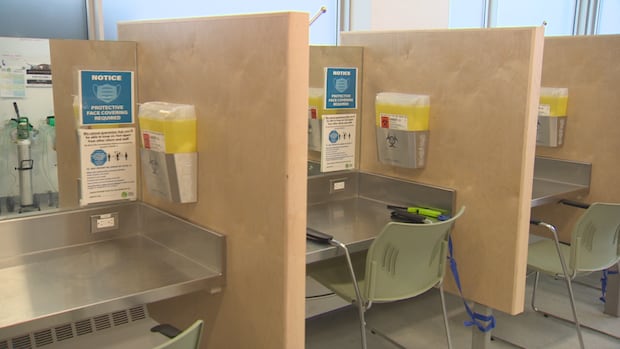Overdoses increasing at Toronto drop-in centres since supervised consumption sites shut down, network says

Overdoses at drop-in centres in Toronto have sharply increased since the provincial government shut down four supervised consumption sites in April, according to a coalition of community agencies.
Before the supervised consumption sites closed, there were typically less than 10 overdoses a month at drop-in sites — which include churches, food banks and neighbourhood centres — said Melanie Joy, manager of the Toronto Drop-In Network.
Now, these sites are reporting overdoses in the high thirties every month, she said.
Joy said this surge is happening throughout the city, not just in the downtown core.
"It's been a dramatic increase, without an increase in resources or supports," she told CBC Radio's Metro Morning on Friday.
This comes as Toronto Public Health (TPH) data shows fatal and non-fatal opioid overdose calls to paramedics are down in 2025 compared to the previous two years.
But Joy says TPH does not track overdoses that are happening in drop-in centres, in the community, or at the remaining supervised consumption sites that are still open.
Downtown church has become an 'injection site'More than 50 community agencies are part of the Toronto Drop-In Network, including Metropolitan United Church, located at Queen Street E. and Church Street.
Between 30 and 50 people use drugs on the church's property over the course of a day, said property manager Frank Cormier.
He said he carries Naloxone on him at all times. Last summer, he said he used it about once a month, but now he's using it two or more times a week.

After the supervised consumption sites closed, Cormier said people who use drugs are lacking spaces to go for support.
"Right now, Metropolitan United Church's front lawn has become the injection site," he told Metro Morning.
On April 1, the province closed nine supervised consumption sites in Ontario — including four in Toronto — that were located within 200 metres of schools or daycares. The legislation is currently being challenged in court by Kensington Market Overdose Prevention Site, a tenth site that was slated to close but is currently still open due to a legal injunction and fundraising.
The nine sites that did close agreed to become Homelessness and Addiction Recovery Treatment (HART) Hubs, an abstinence-based model that provides access to recovery and treatment systems for people struggling with addictions and mental health issues, but does not provide any drug consumption services.
Province says 9 of 28 HART Hubs opened in AprilWhile the HART Hubs were meant to be fully operational by April 1, Joy said that's "not what we're seeing in reality."
As of last month, several of the HART Hubs don't yet appear to have full slates of services up and running. At Toronto Public Health's HART hub, now running temporarily on the Esplanade, only one program of 10 is operational, with the rest planned to get underway this summer or beyond.
The province said in a statement the nine HART Hubs replacing supervised consumption sites "opened, as planned on April 1, including those in Toronto, ensuring no gaps in the delivery of mental health support services."
The government is spending $550 million to build a total of 28 hubs across the province that will provide people with 24/7 support, the statement reads.
It is continuing to work with the remaining 19 hubs "to finalize operational budgets," the statement said.
Joy said HART Hubs offer services that both people working in the sector and those who use drugs have long called for as additions to the supervised consumption site model, such as more detox beds, enhanced one-on-one case management, and counselling.
But she said the hubs do not include key services typically provided by supervised consumption sites, such as access to clean needles, which help reduce the spread of infectious diseases.
"It's frustrating that there wasn't the foresight to include all these services together in one place," Joy said.
Meanwhile, Cormier said the government failed to adequately plan the transition from supervised consumption sites to HART Hubs.
"The system changed suddenly, drastically, and it didn't seem like anybody thought about what the gap is going to be between one model and the next model," he said.
"I think that's just really bad planning and really bad change management."
cbc.ca





